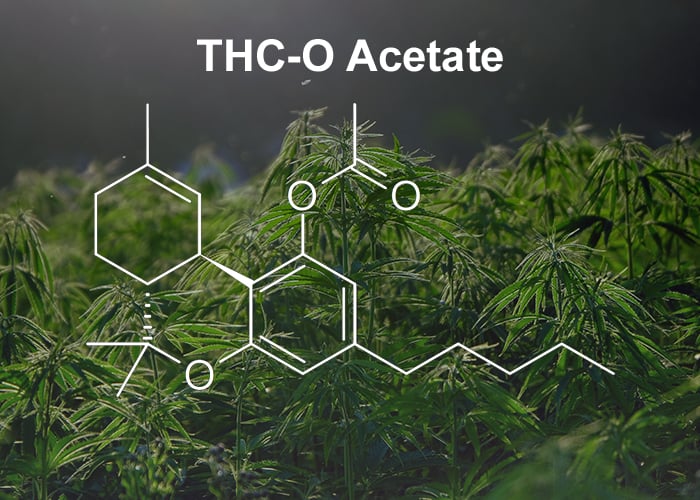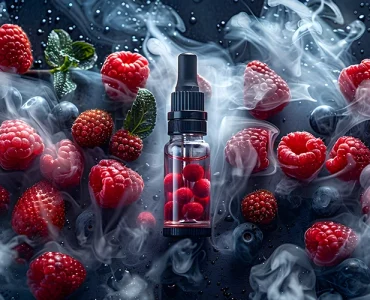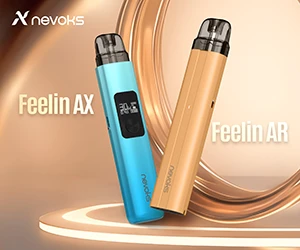Update 02/22/2023
After a period of unknowns and questions, the Drug Enforcement Agency (DEA) has opened up about their views on THC-O’s legal status under the 2018 Farm Bill.
In a letter to Rod Knight, an attorney that specializes in advising hemp and marijuana companies, the DEA stated that THC-O is federally illegal in the eyes of the agency, and will be treated as such.
“Although it can be made from cannabinoids from hemp, THC-O is not naturally expressed by the hemp plant,” stated Knight. “It is a laboratory creation that does not exist in nature, at least not from a hemp plant.”
According to a ruling by the Ninth Circuit Court of Appeals just last year, the Farm Bill still protects all other hemp-derived cannabinoids with the exception of THC-O.
Key Takeaways
- Delta-O THC is unlike many popular cannabinoids because it does not exist naturally in cannabis or hemp plants. It is classified as a synthetic cannabinoid due to the significant chemical processing required to make it.
- THC-O, or THC-O acetate, is made through chemical processes that convert the base hemp compound to delta-8 THC. Acetic anhydride is then bonded to the delta-8 molecule to increase overall bioavailability.
- THC-O has earned the colloquial moniker of the “spiritual cannabinoid” due to its intense psychedelic properties. It is commonly reported to be far stronger than other cannabinoids and should be used with care.
- Despite THC-O being derived from cannabinoids that fall under the Farm Bill, the fact that it is synthesized complicates its legality. The DEA has stated that it considers THC-O illegal, and will be treated as such.
With regulators cracking down on popular cannabinoids like delta-8 THC, consumers and producers have been scrambling to find the next best thing. Enter: THC-O.
Here you’ll find out just about everything you’ve ever wanted to know about this interesting and powerful cannabinoid. We go over what THC-O is, its effects, legality, safety, and how it compares to other cannabinoids.
What is THC-O?
First things first, let’s go over what this compound is. In simple terms, THC-O acetate is a synthetic cannabinoid.
It is a hemp-derived compound, similar to delta-8 and delta-10, that has garnered a lot of interest within the cannabinoid community over the past few years for its interesting and powerful properties.
One of the most attractive points of this compound is its strength. Researchers have found that it boasts up to three times the potency of standard delta-9 tetrahydrocannabinol or THC.
Another reason for this compound’s increasing popularity is its legal status in many states. As the production of THC-O starts off with hemp, it is protected under the Farm Bill. However, like other hemp-derived THC compounds, this can be subject to state law.
Cannabis users from states where only hemp is federally legal have popularized delta-8 THC, but increasing regulations have made these same users flock towards THC-O. The rise in THC-O’s popularity is a direct result of alternatives like delta-8 THC being banned in several states recently.
In turn, this exciting new cannabinoid THC-O seems to have the potential to take the reins as the somewhat-legal cannabinoid of choice.
It is currently available in multiple forms, from vape cartridges and wax dabs, to tinctures and gummies.
What Are the Effects of THC-O?
There are still a lot of unknowns with this compound when it comes to its potential negative effects. However, when it comes to its psychoactive effects, they’re generally well-known and appreciated by many.
THC-O has earned the colloquial moniker of the “spiritual cannabinoid.” This is because it has undeniable psychedelic properties.
You may be wondering, “Does THC-O get you high?”
Yes, it does. Moreover, it is a lot stronger than your run-of-the-mill delta-9 THC.
This has been attributed to the higher bioavailability of THC-O when compared to traditional THC as a result of the acetic anhydride used in its synthesis. What this means is that the body absorbs much greater amounts of the compound when ingested, giving it that stronger kick.
Some have even gone so far as to compare the effects to small doses of Lysergic acid diethylamide (LSD), which is a Schedule I hallucinogenic drug.
Interestingly, despite its higher bioavailability and potency, it is known as a “prodrug.” This term, used by researchers, means that the effects are not felt until the compound has been metabolized by the body. This means the effects of THC-O are not felt for up to 30 minutes after ingestion.
Having a delayed effect like this makes it even more important to take things slowly for the first few times that you are using the compound, in order to avoid taking too much and being sent on an unexpected psychedelic trip.
Is THC-O Safe?
There is still ongoing research into THC-O, and so it hasn’t been deemed fully safe as of yet.
There are certainly some unique considerations when it comes to a highly potent compound like THC-O. Users should be cautious when using this cannabinoid, particularly in the introductory stage. It certainly should not be used with the same levity as traditional THC products.
Additionally, the process of forming the compound means it is very important to use only high-quality products.
“If you’re using low-quality extract material and low-quality reagents you bought online from Alibaba or whatever, you’re likely to get way less pure of a product than if you’re using clean [and pharmaceutical-grade] reagents and do a lot of downstream purification steps,” James Stephens said in a discussion with Leafly.
James Stephens is a Montana-based cannabis researcher and chemist. He has done investigations into various cannabinoids like THC-O with Iron Light.
There are also concerns about the use of a volatile chemical like acetic anhydride in synthesis, particularly when it comes to vaping.
THC-O and Vaping
Like with any other form of consumption, vaping THC-O comes with its own set of guidelines that are worth following when starting out.
Always Choose a High-Quality Product
First, it is of utmost importance to choose a high-quality vape cartridge from a reputable brand that provides lab test results. Researchers have stressed multiple times that THC-O can easily be tainted by improper manufacturing processes, which will tarnish the final product.
This is made even more true when thinking about the various chemical processes that are required to extract and synthesize THC-O from hemp plants. These should always be subject to stringent quality control.
Intensity and Duration
Before consuming THC-O, it is good to wonder, “How long does THC-O last?”
The effects of THC-O typically last between two and four hours, depending on quality, dosage, and the user’s THC tolerance. Again, it can take between 20 and 30 minutes before any effects are felt at all.
This makes it incredibly important not to consume more THC-O within that timeframe to avoid compounding effects after that 30-minute mark.
Potential Health Concerns
There are some serious chemicals involved in synthesizing THC-O and a lack of research means that no one is quite sure of the potential health implications of vaping it just yet.
This is yet another reason why it is imperative to only use high-quality products that are made in professional labs.
Is THC-O Legal?
It’s currently a bit of a gray area in the United States. Despite the compound’s popularity as a legal alternative to delta-9 THC, there is much debate around its legality under the Farm Bill passed in 2018.
As with everything in the world, there are two sides to the debate. On the one hand, consumers and producers of the compound believe it to be protected by the Farm Bill. This is because it is derived from federally legal hemp plants.
The other side argues that THC-O is in breach of the 1986 Federal Analogue Act. This act states that “a controlled substance analog shall, to the extent intended for human consumption, be treated, for the purposes of any Federal law as a controlled substance in Schedule I.”
Often being likened to small doses of LSD, a Schedule I drug, means that THC-O could be considered illegal as an analog to LSD.

How is THC-O Made?
As mentioned earlier, THC-O is originally derived from federally legal hemp. It bears several similarities with other hemp-derived cannabinoids like delta-8 and delta-10 in terms of the manufacturing process.
CBD is extracted from the hemp plant, which is then isolated. The CBD isolate is then synthesized into delta-8 THC.
This is the exact same process used to make delta-8 THC. However, there is a further step that is responsible for the increased bioavailability and potency.
Acetic anhydride, or ethanoic anhydride, is then added to delta-8 THC to finally create THC-O acetate.
What is Acetic Anhydride?
Acetic anhydride is a fairly volatile chemical that is used to make fibers, plastics, pharmaceuticals, dyes, and even explosives.
It is corrosive to metal and tissue and reacts violently with even water.
One of the most glaring downsides of THC-O is the concern when it comes to homemade versions. Acetic anhydride is no joke and should be left to professional labs.
Manufacturers and researchers have both stressed how unsafe the compound and its creation process can be in the DIY context.
Again, the making of THC-O is best left to a pharmaceutical-grade lab.
Does THC-O Show Up on a Drug Test?
Yes, THC-O will definitely show up on a drug test. In fact, it will most likely be more detectable than some of its other cannabinoid counterparts because of its increased potency.
As with traditional THC, its detectability is heavily dependent on various factors. These are things like how often it is ingested, the amounts ingested, and the type of drug test in question.
How long does THC-O last in your system?
Anyone wondering about how the compound will fare in a drug test will likely be wondering how long THC-O remains detectable after ingestion.
In terms of a drug test, it will likely stay in your system for about the same amount of time as traditional THC, with the same augmenting factors like how regularly you consume it.
For those who have only used THC-O once, it will last in your system for 10-15 days. For frequent users who use THC-O consistently, especially those who are using it daily, it can take 30 days or more since your last use to clear from your system.
How Does THC-O Compare to Other Cannabinoids?
With all this new information on THC-O, you may be wondering where it fits in along with the other popular cannabinoids on the market like delta-8, delta-9 THC (found in cannabis), and delta-10. Here is a comparison of the major different cannabinoids, including THC-O.
THC-O
These are some of the most important factors that distinguish THC-O from its cannabinoid cousins.
- Incredibly potent; up to three times stronger than delta-9 THC
- More psychedelic effects than other cannabinoids
- Hemp-derived
- Legal gray area
- Concerns around vaping it
Delta-8 THC
Delta-8 (delta-8-tetrahydrocannabinol) is found in small amounts in the cannabis plant.
It bears a number of similarities with the sought-after delta-9 THC that everyone associates with cannabis. However, it is noticeably less potent than delta-9.
Because of its reduced strength, it is often preferred by some for its milder, more manageable high. It is also chosen for its more relaxing effects.
It can be derived from federally legal hemp, as well as cannabis plants, making it legal under the Farm Bill. This also makes it a popular alternative for people in states where cannabis is not yet legal.
Delta-8 is made by extracting CBD from hemp. It is then refined into CBD isolate. Delta-8 THC is then synthesized from this CBD isolate.
- Much less potent than THC-O or Delta-9 THC
- Sedating high, often referred to as Indica-like
- Hemp-derived
- Legal gray area
Delta-9 THC
The cannabinoid that needs no introduction. Delta-9 is the benchmark THC compound. This is what is found naturally in cannabis products, giving it its desired effects from consumption.
The potency of delta-9 is dependent on the strain and product being consumed, making some products much stronger than others. However, it is much milder than THC-O.
It goes without saying that delta-9 is still outlawed in many states. While this is slowly changing, many states have not budged, making hemp-derived alternatives like delta-8, delta-9, and THC-O a necessity.
- Benchmark potency
- Legal status fluctuates from state to state
- Naturally occurring
- Illegal in many states
Delta-10 THC
Delta-10 shares a number of similarities with delta-8 THC.
It is also a hemp-derived cannabinoid, made from synthesizing CBD isolate into delta-10. One important differentiator between the two is that delta-10 is much harder to manufacture, resulting in much lower yields.
Many people have reported experiencing a more energizing high compared to the calming effects of delta-8.
- Much less potent
- Energizing high, often referred to as Sativa-like
- Hemp-derived
- Legal gray area
To Wrap Up
With federal law allowing hemp, but outlawing cannabis, manufacturers have scrambled to find hemp-derived cannabinoids that imitated the delta-9 that is naturally found in marijuana. THC-O is one such cannabinoid that is gathering quite a reputation across the United States.
Its immense potency has led to both popularity among users and criticism from regulators. While it is still protected under the Farm Bill, this may change in the near future as more attention is being drawn to this compound.
For those wanting to enjoy it while they can, start slow and enjoy the ride.










Very interesting how these cannabiniods can by isolated separated and changed biochemically